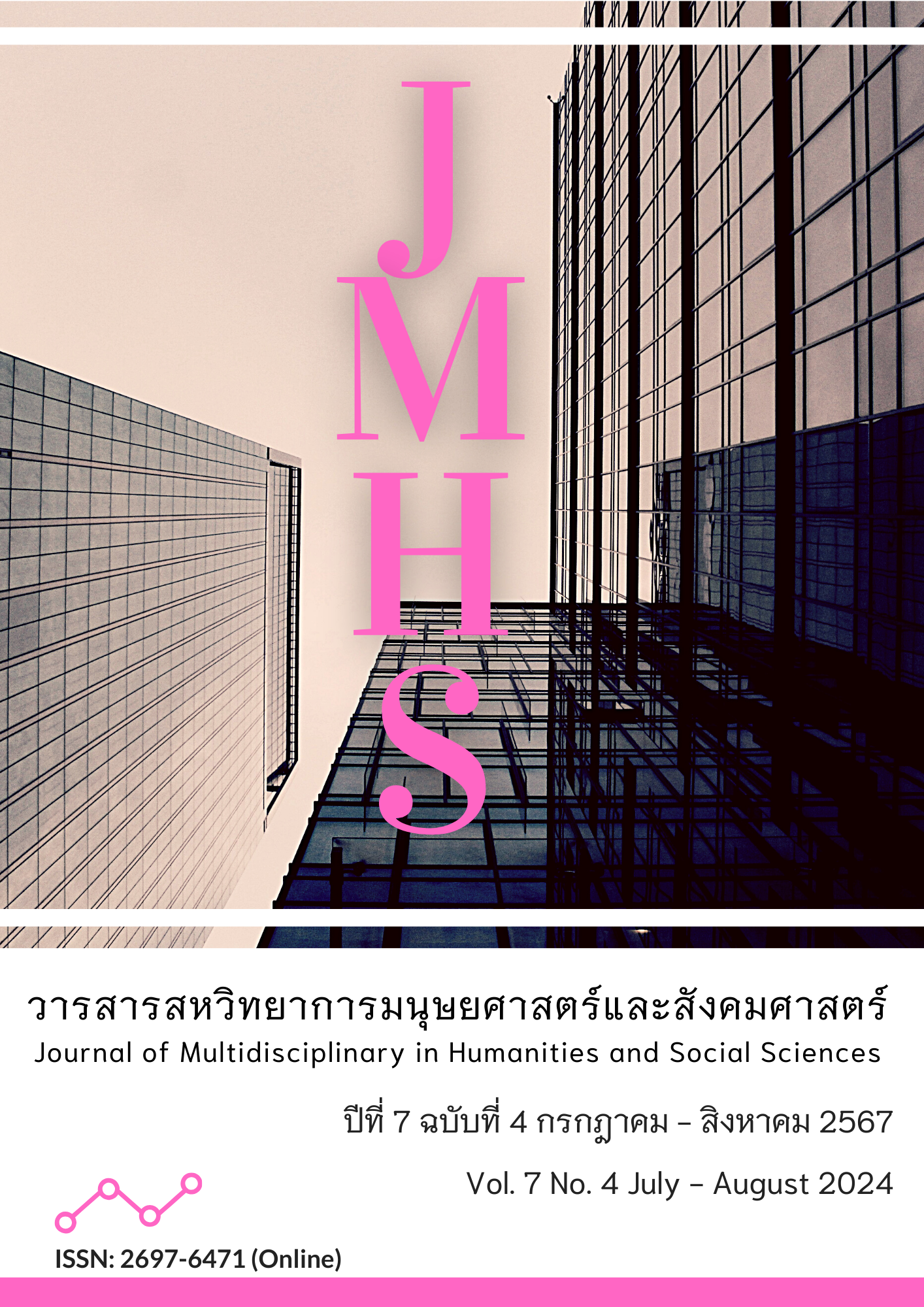The Insistence, Coping, and Adaptation of the Tha-Chin Riverside Market Communities
Main Article Content
Abstract
This qualitative research aimed to study the dynamics of change and analyze conditions and factors for the survival of the Tha Chin Riverside Market communities. There were 3 groups of 81 key informants, i.e., 1) 27 government sectors, 2) 27 private sectors, and 3) 27 communities, using the snowball technique. Data were collected using document analysis, observation (the observation form), and interviews (the interview form), and the data were analyzed using content analysis. The research results were as follows: 1) The Tha Chin Riverside Market communities had mostly residents who were Thai-Chinese who had immigrated. Them's houses were two-story wooden shophouses facing each other that were more than a hundred years old; on the ground floor there were shops, and currently still inheriting Chinese culture that was the combination of various cultures spread through technology; 2) the dynamics of standing, defending, and adapting the communities were divided into 2 eras: the port era (1916–1996), which was the center for exchanging goods by boat from inside and outside the communities; and the city travel era (1997–2023), which was a place for buying and selling products according to the way of life of people in the communities that still maintains the culture and architecture. There were changes to the tourist attraction; and 3) conditions and factors for the existence of the Tha Chin Riverside Market communities were: leaders' abilities, communities’ participation, knowledge management, and cultural capital.
Article Details

This work is licensed under a Creative Commons Attribution-NonCommercial-NoDerivatives 4.0 International License.
Views and opinions appearing in the Journal it is the responsibility of the author of the article, and does not constitute the view and responsibility of the editorial team.
References
กฤตพร ห้าวเจริญ. (2560). วิถีท้องถิ่นและผังกายภาพของตลาดชุมชนริมแม่น้ำท่าจีน กรณีศึกษาจังหวัดสุพรรณบุรีและจังหวัดนครปฐม. วารสารวิชาการคณะสถาปัตยกรรมศาสตร์ สจล., 26(Arch Issue), 13-29.
ดาราณี โฉมเผือก. (2564). เครือข่ายกระบวนการอนุรักษ์ลุ่มแม่น้ำท่าจีนของชุมชนดอนหวาย อำเภอสามพราน จังหวัดนครปฐม. วารสาร มจร พุทธปัญญาปริทรรศน์, 5(1), 12-23.
ไทย พีบีเอส. (2563). ท่าจีน มหานทีแห่งสีสัน: รู้สู้ภัย Don't Panic. สืบค้นจาก https://www.youtube.com/watch?v=Cqu26_fG3RM
บุษบา ทองอุปการ, สันติ ศรีสวนแตง และ วีรฉัตร์ สุปัญโญ. (2560). แนวทางเสริมสร้างความเข้มแข็งทุนชุมชนบ้านตลิ่งแดง จังหวัดกาญจนบุรี. Kasetsart Journal of Social Sciences (KJSS), 38, 600–610.
ปรมินทร์ วงษ์คําสิงห์ และ ณัฎฐ์ รัตนศิริณิชกุล. (2566). การพัฒนาเทคโนโลยีเสมือนจริงเพื่อส่งเสริมทักษะการใช้เทคโนโลยีดิจิทัลเพื่อการจัดการเรียนรู้ของครูสังกัดสำนักงานส่งเสริมการศึกษานอกระบบและการศึกษาตามอัธยาศัย จังหวัดลําปาง. วารสารวิจัยมหาวิทยาลัยเวสเทิร์น มนุษยศาสตร์และสังคมศาสตร์, 9(1), 117-130.
เสกสรรค์ สนวา. (2561). ทฤษฎีขบวนการเลื่อนไหวทางสังคมและการประท้วงทางการเมือง. วารสารมหาวิทยาลัยราชภัฏยะลา, 13(12), 359-362.
สุจิตต์ วงษ์เทศ. (2561). ชุมชนจีนเก่าแก่ แม่น้ำท่าจีน สมุทรสาคร. มติชนออนไลน์. สืบค้นจาก https://www.matichon.co.th/prachachuen/dailycolumn/news_838725
สำนักงานสภาพัฒนาการเศรษฐกิจและสังคมแห่งชาติ. (2564). แผนพัฒนาเศรษฐกิจและสังคมแห่งชาติ. สืบค้นจาก https://www.nesdc.go.th/main.php?filename=plan13
โสรัตน์ มงคลมะไฟ (2566). การใช้สื่อสังคมออนไลน์มีผลต่อความสัมพันธ์กับสังคมของนักศึกษาคณะบริหารธุรกิจ มหาวิทยาลัยเทคโนโลยีราชมงคลรัตนโกสินทร์ วิทยาเขตวังไกลกังวล. วารสารนวัตกรรมการบริหารและการจัดการ, 11(2), 25-36.
อรทัย พรมเทพ, สันติ ศรีสวนแตง และ วีรฉัตร์ สุปัญโญ. (2560). กระบวนการเรียนรู้และถ่ายทอดศิลปะการแสดงพื้นบ้านหนังตะลุงในจังหวัดสงขลา. Kasetsart Journal of Social Sciences (KJSS), 38, 623-635.
Maliphan, S., Srisuantang, S., & Yamtim, V. (2020). Knowledge space and modifying a mode of agricultural production among the Karen communities in Omkoi District, Chiang Mai Province. Kasetsart Journal of Social Sciences, 41(3), 469–474.
Miettinen, R. (2020). Theories of invention and an industrial innovation. ResearchGate, 9(2),34-48.
Sa-adthien, S., Tanpichai, P., & Jai-aree, A. (2020). Community resilience for the survival in flooded areas Nakhon Sawan province. Kasetsart Journal of Social Sciences, 41(3), 481-486.
Sil, R., & Chatterjee, R. (2023). Evolution of Next-Generation Communication Technology. 5G and Beyond.
Sriwichien, K., Keeratiboorana, Y., & Soungsaweng, W. (2014). The fall, existence and a restoration model of community bazaars along the Tha Chin river. Asian Social Science, Canadian Center of Science and Education. 10(1), 257-264.
Sriwichien, K., Keeratiboorana, Y., & Soungsaweng, W. (2015). The decline of local riverside markets in Suphanburi Province, Thailand. Asian Culture and History, 7(1). DOI:10.5539/ach.v7n1p49.
Tushar, H. et al. (2018). Employing a transformative learning process for promoting sustainable business model through organic agriculture: A case study of the Sampran riverside. Theresa Journal of Humanities and Social Sciences, 4(2), 67-92.
Traimongkokul, P. Tunpichai, P., Srisuantang, S., & Ying-Yuad, N. (2007). University-local school collaboration in agricultural and environment education. Kasetsart Journal of Social Sciences, 28(3), 342–350.
Tanpichai, P., Supnui, K., & Srisuantang, S. (2016). Network linkage and learning-based development for mushroom production. Kasetsart Journal of Social Sciences, 37(3), 255–266.
Thongsri, S., Niamhom, W., & Srisuantang, S., (2019). The mobility of small fisheries community with knowledge management for conservation and restoration of the marine and coastal resource in the Gulf of Thailand, SongKhla province. PSAKU International Journal of Interdisciplinary Research, 8(Special Issue), 57-66.
Udomwech, A., Jai-Aree, A., & Srisuantang, S. (2020). Reflection on learning experience for self-management: The concept and practices of Sanam Chai Khet organic agricultural group, Chachoengsao province, Thailand. Kasetsart Journal of Social Science, 41(1), 68-74.


